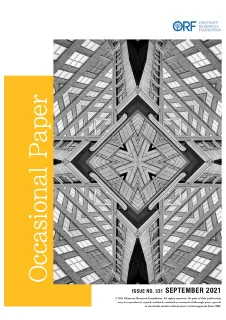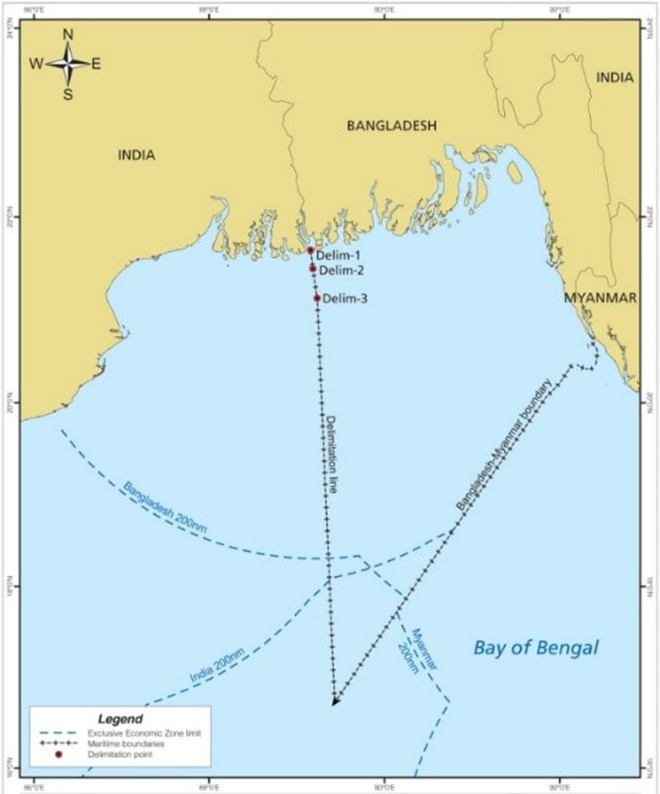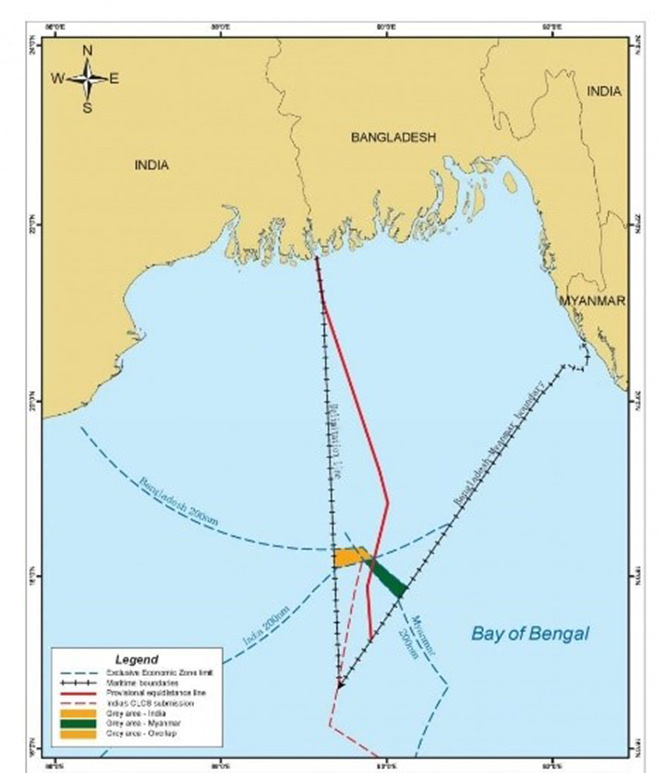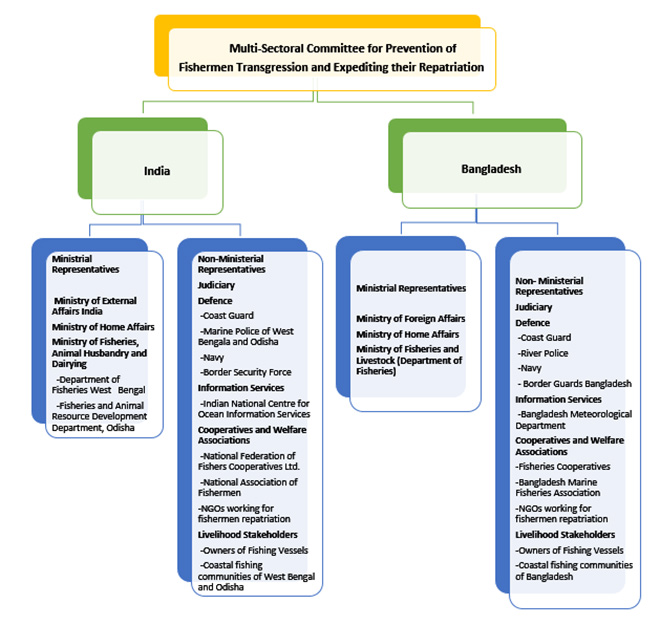[a] The northern coastline of the Bay of Bengal comprises the coast of West Bengal in India which runs for 157 km and the coast of Bangladesh which is 580 km long. Therefore, the calculated total length of the northern coast of the Bay is 737 km.
[b] The PCA is an intergovernmental organisation established in 1899, which provides an array of dispute resolution services to the international community.
[c] Non-traditional security threats are challenges to the security of countries and the well-being of its people that arise out of non-state or non-military sources.
[d] The United Nations Convention for Laws of the Sea (UNCLOS) 1982, delimited the four areas of maritime rights as: Territorial Sea-12 nautical miles-nm in which the state exercises full legal sovereignty; Contiguous Zones-24 nm in which the state exercises limited sovereignty; the Exclusive Economic Zones-200 nm in which the state exercises full economic sovereignty; and the Continental Shelf- 350 nm (maximum) in which the state exercises limited economic sovereignty.
[e] These states are West Bengal, Odisha, Andhra Pradesh and Tamil Nadu.
[f]BOBLME is an internationally funded initiative to facilitate trans-boundary collaboration for marine fisheries and environmental issues.
[g] The ITLOS is an independent judicial body established by the UNCLOS in 1982. It has jurisdiction over any dispute concerning the interpretation or application of the Convention, and over all other matters which are specifically provided for in any other agreement which confers jurisdiction on the Tribunal.
[h] As a set of international laws, the UNLCOS is not legally binding on its signatories. These countries can therefore choose to adhere to their own laws over the terms of the UNCLOS in areas which fall within national jurisdiction.
[i] Bangladesh’s considerably guarded stance in punishing transgressors, as evident from the articulation of its laws, may be attributed to it being more decisively cautious of its sovereignty and territorial rights compared to India. This can be traced to it being a more newly independent country and the fact that it has a smaller coastline with a critical dependence on fisheries for food and financial security.
[j] Barren and uninhabited except for a Catholic Church which fishers made pilgrimages to, the Kachchteevu island appeared without any strategic significance to the Indian government.
[k] In the 1970s, India and Sri Lanka relations was characterised by the personal rapport between the then Sri Lankan Prime Minister Sirimavo Bandaranaike and the then Indian Prime Minister Indira Gandhi. Consequently, many issues in the bilateral ties were glossed over by personal diplomacy.
[l] The method of ‘bottom trawling’ severely harms the ocean bed and thus causes the depletion of fish stocks.
[m] Tamil fishers who fled to Tamil Nadu from Sri Lanka fearing persecution, accompanied Indian fishers to identify Sri Lanka’s rich fishing blocks.
[n] There have also been instances of Indian fishers being killed by the Pakistan Maritime Security Agency.
[o] Geofencing is a modern service that triggers alerts when a device enters a designated location. It is increasingly being used to ensure that fishermen do not transgress maritime boundaries. But trans-boundary cooperation between neighbouring countries is required for its effective implementation to ensure that the decreed maritime boundary lines are adhered by all involved parties, thereby reducing the scope for future friction.
[q] Bay of Bengal Multi-Sectoral Technical and Economic Cooperation- the regional organisation exclusive to the Bay of Bengal.
[1] Permanent Court of Arbitration, In the matter of the Bay of Bengal Maritime Boundary Arbitration-between-the People’s Republic of Bangladesh-and-the Republic of India, The Hague, July 7, 2014.
[2]A. Subramanyam Raju, “The (In)Security of Fishermen in South Asia,” in Fisheries Exploitation in the Indian Ocean: Threats and Opportunities, ed. Dennis Rumley, Sanjay Chaturvedi and Vijay Sakhuja (Singapore: Institute of Southeast Asian Studies, 2009), 163.
[3] “Bangladesh releases 178 Indian fishermen,” The News Minute, January 16, 2016, https://www.thenewsminute.com/article/bangladesh-releases-178-indian-fishermen-37589
[4] Government of India, Ministry of External Affairs, QUESTION No.1556 INDIAN FISHERMEN IN BANGLADESH CUSTODY, Media Center, November 27, 2019, https://mea.gov.in/lok-sabha.htm?dtl/32105/QUESTION+No1556+INDIAN+FISHERMEN+IN+BANGLADESH+CUSTODY
[5]Ariful Islam Mithu, “Lost at sea: How Bangladeshi fishermen end up in Indian jails,” The Business Standard, November 23, 2020, https://tbsnews.net/feature/panorama/lost-sea-how-bangladeshi-fishermen-end-indian-jails-92935
[6] Shahidul Hasan Khokkon, “16 Indian fishermen sent to Bangladesh jail for crossing maritime boundary,” India Today, December 25, 2020, https://www.indiatoday.in/world/story/16-indian-fishermen-sent-to-bangladesh-jail-for-crossing-maritime-boundary-1752897-2020-12-25
[7] Ahad Chowdhury Tuhin, “13 Indian fishermen detained for illegal intrusion into Bangladesh,” The Dhaka Tribune, August 08, 2021, https://www.dhakatribune.com/bangladesh/2021/08/08/13-indian-fishermen-detained-for-illegal-intrusion-into-bangladesh
[8]Gulbin Sultana, “Issues in India-Sri Lanka Ties,” Issue Brief, Manohar Parriker Institute for Defense Studies and Analyses, March 19, 2021, https://idsa.in/issuebrief/issues-in-india-sri-lanka-ties-gsultana-190321#:~:text=Irritants%20in%20Ties&text=Four%20Indian%20fishermen%20died%20due,craft%20on%20January%2018%2C%202021.&text=The%20loss%20of%20life%20of,are%20due%20in%20May%202021.
[9] Mark E. Rosen, JD, LLM, and Douglas Jackson, “Bangladesh v. India: A Positive Step Forward in Public Order of the Seas,” CNA, September 2017, 31, https://www.cna.org/cna_files/pdf/DOP-2017-U-016081-Final.pdf
[10] Vani Manocha, “Bangladesh wins maritime dispute with India,” Down To Earth, July 4, 2015, https://www.downtoearth.org.in/news/bangladesh-wins-maritime-dispute-with-india-45193
[11]United Nations, Maritime Space: Maritime Zones and Maritime Delimitation, https://www.un.org/Depts/los/LEGISLATIONANDTREATIES/introduction.htm
[12] “In the Matter of The Bay of Bengal Maritime Boundary Arbitration-between- The People’s republic of Bangladesh and The Republic of India.”
[13]Rupak Bhattacharjee, “Delimitation of Indo-Bangladesh Maritime Boundary,” IDS Comment, August 19, 2014, https://idsa.in/idsacomments/DelimitationofIndo-Bangladesh_rbhattacharjee_190814
[14] Permanent Court of Arbitration, Bay of Bengal Maritime Boundary Arbitration between Bangladesh and India, The Hague, July 8, 2014, https://pcacases.com/web/sendAttach/410
[15] Mohammad Arju, “Lines on water cannot save Bay of Bengal fisheries,” The Third Pole, 15 May 2020, https://www.thethirdpole.net/2020/05/15/going-beyond-bay-of-bengal/
[16] Mohammad Mahmudul Islama, Md MostofaShamsuzzamana, Mohammad Mojibul Hoque Mozumder, Xu Xiangmin, Yu Mingb and Md. Abu Sayed Jewel, “Exploitation and conservation of coastal and marine fisheries in Bangladesh: Do the fishery laws matter?,” Marine Policy 76 (February 2017), 143-151, https://www.sciencedirect.com/science/article/abs/pii/S0308597X1630553X?via%3Dihub
[17]Dennis Rumley, “A Policy Framework for Fisheries Conflict in the Indian Ocean,” in Fisheries Exploitation in the Indian Ocean: Threats and Opportunities, ed. Dennis Rumley, Sanjay Chaturvedi and Vijay Sakhuja (Singapore: Institute of Southeast Asian Studies, 2009), 57.
[18]Masuma Parveen, “India: Illegal Fishing Off West Bengal Causing Fish Scarcity,” Benar News, February 12, 2016, https://www.benarnews.org/english/news/bengali/bengal-fishing-02122016131907.html
[19] “22-day hilsa fishing ban from Oct 12,” The Daily Star, August 24, 2021, https://www.thedailystar.net/backpage/22-day-hilsa-fishing-ban-oct-12-1293139
[20] Milan Datta, “Laws flouted, Hilsa dies In West Bengal,” The Third Pole, November 27, 2018, https://www.thethirdpole.net/en/nature/laws-flouted-hilsa-dies-in-west-bengal/
[21] Government of India, “Sustainability,” Marine Products Export Development Authority, https://mpeda.gov.in/?page_id=589
[22] “65-day fishing ban at sea to begin May 20,” The Daily Star, May 18, 2021, https://www.thedailystar.net/city/news/65-day-fishing-ban-sea-begin-may-20-2094117
[23] Mohammad Arju, “Lines on water cannot save Bay of Bengal fisheries.”
[24] Mohammad Arju, “Lines on water cannot save Bay of Bengal fisheries.”
[25] Alin Kadfak, Nathan Bennett, and Raphaella Prugsamatz, “Scoping Study on Migrant Fishers and Transboundary Fishing in the Bay of Bengal,” Bay of Bengal Large Marine Ecosystem Project, 2012, 36, https://www.boblme.org/documentRepository/BOBLME-2012-Socioec-03.pdf
[26] “Bangladesh’s arrests of fishermen surprising,” The Hindu, August 24, 2019, https://www.thehindu.com/news/national/bangladeshs-arrests-of-fishermen-surprising/article7572822.ece
[27] “Scoping Study on Migrant Fishers and Transboundary Fishing in the Bay of Bengal,” 40.
[28] Tafsir Malick Ndiaye, “The judge, maritime delimitation and the grey areas,” Indian Journal of International Law 55 (2015), https://doi.org/10.1007/s40901-016-0027-2
[29] Arpita Goswami, “The Award and its Implications: Bay of Bengal Delimitation,” Economic and Political Weekly 49, no. 29 (July 19, 2014), https://www.epw.in/journal/2014/29/web-exclusives/award-and-its-implications.html
[30] “UNCLOS Annex VII Tribunal decides Bangladesh-India maritime boundary dispute,” Herbert Smith Freehills, July 15, 2014, https://hsfnotes.com/arbitration/2014/07/15/unclos-annex-vii-tribunal-decides-bangladesh-india-maritime-boundary-dispute/#:~:text=In%20effect%2C%20the%20Tribunal%20in,a%20potential%20entitlement%20to%20the
[31] Arpita Goswami, “The Award and its Implications: Bay of Bengal Delimitation.”
[32] Cornell Overfield, “Reflecting the Law of the Sea: In Defense of the Bay of Bengal’s Grey Area,” Centre for International Maritime Security, July 22, 2020, https://cimsec.org/reflecting-the-law-of-the-sea-in-defense-of-the-bay-of-bengals-grey-area/
[33]Arpita Goswami, “The Award and its Implications: Bay of Bengal Delimitation.”
[34] Arpita Goswami, “The Award and its Implications: Bay of Bengal Delimitation.”
[35]Khondker Murshed-e-Jahana, Ben Beltona and K. KuperanViswanathan, “Communication strategies for managing coastal fisheries conflicts in Bangladesh,” Ocean and Coastal Management 92 (May 2014), https://www.sciencedirect.com/science/article/pii/S0964569114000052
[36] “Scoping Study on Migrant Fishers and Transboundary Fishing in the Bay of Bengal,” 42
[37] Government of India, Ministry of External Affairs, “Question nos. 55 Indian fishermen in foreign jails,” Lok Sabha, Media Center, July 20, 2016, https://www.mea.gov.in/lok-sabha.htm?dtl/27075/QUESTION+NO55+INDIAN+FISHERMEN+IN+FOREIGN+JAILS
[38] “61 Indian fishermen pushed back after release from Bagerhat jail,” Dhaka Tribune, March 30, 2021, https://www.dhakatribune.com/bangladesh/2021/03/30/61-indian-fishermen-pushed-back-after-release-from-bagerhat-jail
[39] “26 Indian fishermen detained for intrusion in Bagerhat,” Dhaka Tribune, January 18, 2020, https://www.dhakatribune.com/bangladesh/nation/2020/01/18/26-indian-fishermen-detained-for-intrusion-in-bagerhat
[40] “12 Indian fishermen detained in Bay,” Prothom Alo, February 09, 2020, https://en.prothomalo.com/bangladesh/12-Indian-fishermen-detained-in-Bay
[41] “1,487 Indian prisoners lodged in jails of Bangladesh, Nepal, Pakistan and Lanka: MEA,” The New Indian Express, March 11, 2020, https://www.newindianexpress.com/nation/2020/mar/11/1487-indian-prisoners-lodged-in-jails-of-bangladesh-nepal-pakistan-and-lanka-mea-2115354.html
[42]Vijaysinh Parmar, “Eighty Indians including 38 fishermen lodged in Bangladesh’s,” Times of India, May 28, 2020, https://timesofindia.indiatimes.com/india/eighty-indians-including-38-fishermen-lodged-in-bangladeshs-prisons-mea-in-reply-to-rti-plea/articleshow/76066585.cms
[43]Ariful Islam Mithu, “Lost at sea: How Bangladeshi fishermen end up in Indian jails,” The Business Standard, June 14, 2020, https://www.tbsnews.net/feature/panorama/lost-sea-how-bangladeshi-fishermen-end-indian-jails-92935
[44]Shubhajit Roy, “Dhaka raises concern on ‘rise in killings at border by BSF, Indian nationals’,” The Indian Express, August 20, 2020, https://indianexpress.com/article/india/dhaka-raises-concern-on-rise-in-killings-at-border-by-bsf-indian-nationals-6561834/
[45] “17 Indian fishermen detained for illegal intrusion into Bangladesh,” South Asia Monitor, December 3, 2020, https://southasiamonitor.org/region/17-indian-fishermen-detained-illegal-intrusion-bangladesh
[46]“63 Indian fishermen freed from Bagerhat jail,” New Age Bangladesh, January 29, 2020, https://www.newagebd.net/article/98077/63-indian-fishermen-freed-from-bagerhat-jail
[47] “Over 519 Indian fishermen held, 32 trawlers seized in Patuakhali,” The Daily Star, July 07, 2019, https://www.thedailystar.net/country/over-400-indian-fishermen-held-32-trawlers-seized-in-patuakhali-1767979
[48] “23 Indian fishermen arrested for intrusion, sent to jail in Bagerhat,” Dhaka Tribune, October 06, 2019, https://www.dhakatribune.com/bangladesh/nation/2019/10/06/23-indian-fishermen-arrested-for-intrusion-sent-to-jail-in-bagerhat-2
[49] “Indian Coast Guard and Bangladeshi counterpart join efforts to repatriate 516 Indian fishermen, 32 boats,” The Statesman, July 17, 2019, https://www.thestatesman.com/india/indian-coast-guard-and-bangladeshi-counterpart-join-efforts-to-repatriate-516-indian-fishermen-32-boats-1502778838.html
[50] SM NajmusSakib, “Bangladesh to send over 500 fishermen back to India,” AA, September 14, 2019, https://www.aa.com.tr/en/asia-pacific/bangladesh-to-send-over-500-fishermen-back-to-india/1531113
[51] Government of India, Ministry of External Affairs, “Statement showing year-wise and country-wise apprehension of Indian fishermen and their release,” March 14, 2018, https://mea.gov.in/Images/attach/lu3001.pdf
[52] Government of India, Ministry of External Affairs, “Statement showing year-wise and country-wise apprehension of Indian fishermen and their release.”
[53] Government of India, Ministry of External Affairs, “Statement showing year-wise and country-wise apprehension of Indian fishermen and their release.”
[54] Government of India, Ministry of External Affairs, “Statement showing year-wise and country-wise apprehension of Indian fishermen and their release.”
[55] Government of India, Ministry of External Affairs, “Statement showing year-wise and country-wise apprehension of Indian fishermen and their release.”
[56] Government of India, Ministry of External Affairs, “Statement showing year-wise and country-wise apprehension of Indian fishermen and their release.”
[57] “Modi’s intervention sought for securing release of fishermen,” Business Standard, December 11, 2014.
[58] “GOI must take steps to expedite release of Bengali fishermen arrested by Bangladesh,” AITC, December 16, 2014.
[59]Government of India, Ministry of Fisheries, Animal Husbandry and Dairying, National Fisheries Policy (2020), Press Information Bureau, September 15, 2020.
[60] National Fisheries Policy, Government of India, 2020, 6.
[61]Government of India, Ministry of Fisheries, Animal Husbandry and Dairying, National Fisheries Policy (2020), 22.
[62]Government of India, Ministry of Fisheries, Animal Husbandry and Dairying, National Fisheries Policy (2020), 9.
[63]Government of India, Ministry of Fisheries, Animal Husbandry and Dairying, National Fisheries Policy (2020), 9.
[64]Government of the People’s Republic of Bangladesh, Ministry of Fisheries and Livestock, National Fisheries Policy, 1998.
[65] Government of India, The Department of Animal Husbandry and Dairying, Ministry of Fisheries, Animal Husbandry and Dairying, The Maritime Zones of India (Regulation of Fishing by Foreign Vessels Act, 1981), 1981.
[66] “Scoping Study on Migrant Fishers and Transboundary Fishing in the Bay of Bengal,” 44
[67] Government of Bangladesh, The Marine Fisheries Ordinance, Ordinance Number XXXV of 1983.
[68] Government of Bangladesh, “সামুদ্রিক মৎস্য (Marine Fisheries) আইন, ২০২০,” or Marine Fisheries Act of 2020.
[69] United Nations, United Nations Convention on the Law of the Sea, 31.
[70] United Nations Convention on the Law of the Sea, 31.
[71] United Nations Convention on the Law of the Sea, 52.
[72] Government of India, Ministry of External Affairs, MOU between India and Bangladesh on co-operation in the field of fisheries, Media Center, September 06, 2011.
[73] Government of India, Ministry of External Affairs, Memorandum of Understanding between the Government of the Republic of India and the Government of the People’s Republic of Bangladesh in the field of Blue Economy and Maritime Co-operation in the Bay of Bengal and the Indian Ocean Region, Dhaka, June 06, 2015.
[74] Government of India, Ministry of External Affairs, Memorandum of Understanding between the Indian Coast Guard and Bangladesh Coast Guard for the Establishment of Collaborative Relationship to Combat Transnational Illegal Activities at Sea and Develop Regional Cooperation signed between the Indian Coast Guard and Bangladesh Coast Guard, Dhaka, June 2015.
[75] “India, Bangladesh agree on fast repatriation of fishermen,” The Economic Times, 9 September 2015.
[76] Haroon Habib, “India-Bangladesh extradition treaty takes effect,” The Hindu, October 23, 2013.
[77]“External affairs minister Jaishankar wraps up official visit to Sri Lanka,” Business Standard, January 07, 2021.
[78]V.Suryanarayan, “The India–Sri Lanka Fisheries Dispute: Creating a Win-Win in the Palk Bay,” Carnegie India (September 09, 2016).
[79] United Nations, “Agreement between Sri Lanka and India on the Boundary in Historic Waters between the two Countries and Related Matters 26 and 28 June 1974,” Delimitation Treatise Infobase.
[80]“Agreement between the Government of India and the Government of the Republic of Sri Lanka on the Maritime Boundary in the Gulf of Manaar and the Bay of Bengal,” New Delhi, 23 March 1976.
[81] A Subramanyam Raju, “The (In)Security of Fishermen in South Asia,” 165.
[82]N. Manoharan and Madhumati Deshpande, “Fishing in the Troubled Waters: Fishermen Issue in India–Sri Lanka Relations,” India Quarterly 74, no.1 (January 14, 2018): 77, DOI: 10.1177/0974928417749643
[83]Muttukrishna Sarvananthan, “Envisioning a smart resolution to fishing disputes between India and Sri Lanka,” Maritime Affairs: Journal of the National Maritime Foundation of India 18, no.2 (January 06, 2019): 96.
[84]N. Manoharan and Madhumati Deshpande, “Fishing in the Troubled Waters: Fishermen Issue in India–Sri Lanka Relations,” 80.
[85] Poonkuzhali, “Sea of sorrows,” The Indian Express, February 4, 2021.
[86]N. Manoharan and Madhumati Deshpande, “Fishing in the Troubled Waters: Fishermen Issue in India–Sri Lanka Relations,” 80.
[87]Muttukrishna Sarvananthan, “Envisioning a smart resolution to fishing disputes between India and Sri Lanka,” 100.
[88]V.Suryanarayan, “The India–Sri Lanka Fisheries Dispute: Creating a Win-Win in the Palk Bay.”
[89] Government of India, Ministry of External Affairs, Question No.1201 Indian Fishermen Killed by Sri Lankan Navy, Media Center, February 11, 2021.
[90]N. Manoharan and Madhumati Deshpande, “Fishing in the Troubled Waters: Fishermen Issue in India–Sri Lanka Relations,” 86.
[91] Poonkuzhali, “Sea of sorrows.”
[92]N. Manoharan and Madhumati Deshpande, “Fishing in the Troubled Waters: Fishermen Issue in India–Sri Lanka Relations,” 84.
[93]Muttukrishna Sarvananthan, “Envisioning a smart resolution to fishing disputes between India and Sri Lanka,” 97.
[94]V.Suryanarayan, “The India–Sri Lanka Fisheries Dispute: Creating a Win-Win in the Palk Bay.”
[95]Muttukrishna Sarvananthan, “Envisioning a smart resolution to fishing disputes between India and Sri Lanka,” 97.
[96] Government of India, Economic Advisory Council to the Prime Minister, India’s Blue Economy- A Draft Policy Framework, New Delhi, September 2020, 11.
[97]Government of India, Economic Advisory Council to the Prime Minister, India’s Blue Economy- A Draft Policy Framework, 26
[98] Md. Khurshed Alam, “Blue Economy- Development of Sea Resources for Bangladesh,” Ministry of Foreign Affairs, Government of Bangladesh, Last updated October 31, 2019.
[99] Md. Khurshed Alam, “Blue Economy- Development of Sea Resources for Bangladesh.”
[100] V. Suryanarayan, “Resolving the fishing dispute in Palk bay,” The New Indian Express, January 18, 2021.
[101] A Subramanyam Raju, “The (In)Security of Fishermen in South Asia,” 174.
[102] Constantino Xavier, “Bridging the Bay of Bengal: Toward a Stronger BIMSTEC,” Carnegie India, February 22, 2018.

 PDF Download
PDF Download





 Source:
Source: PREV
PREV


